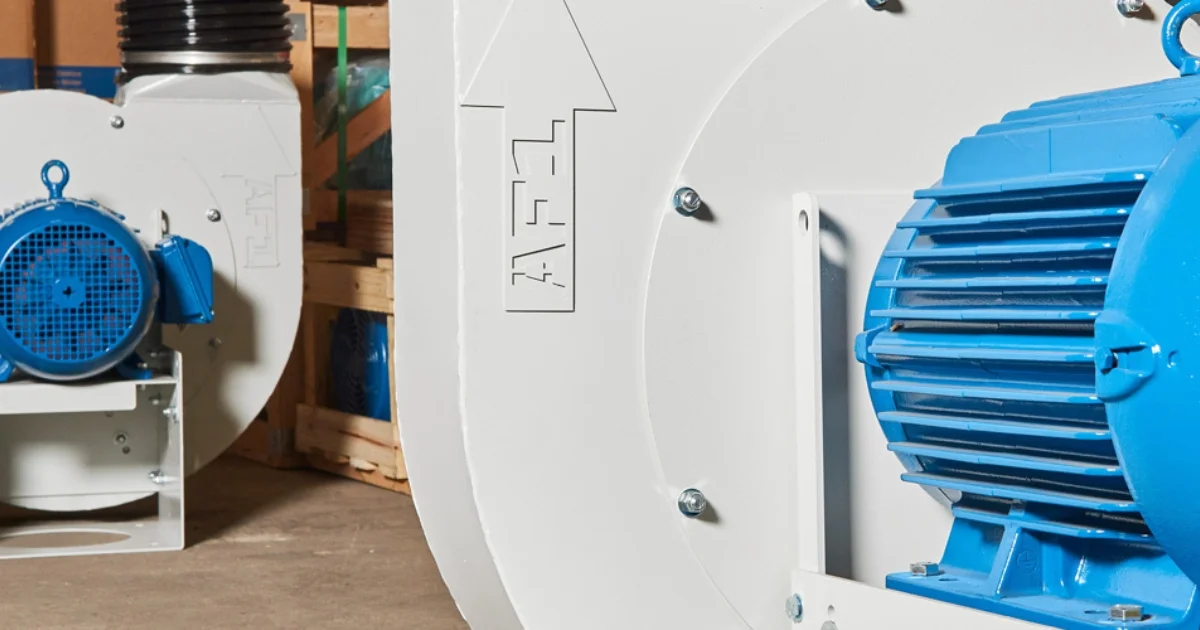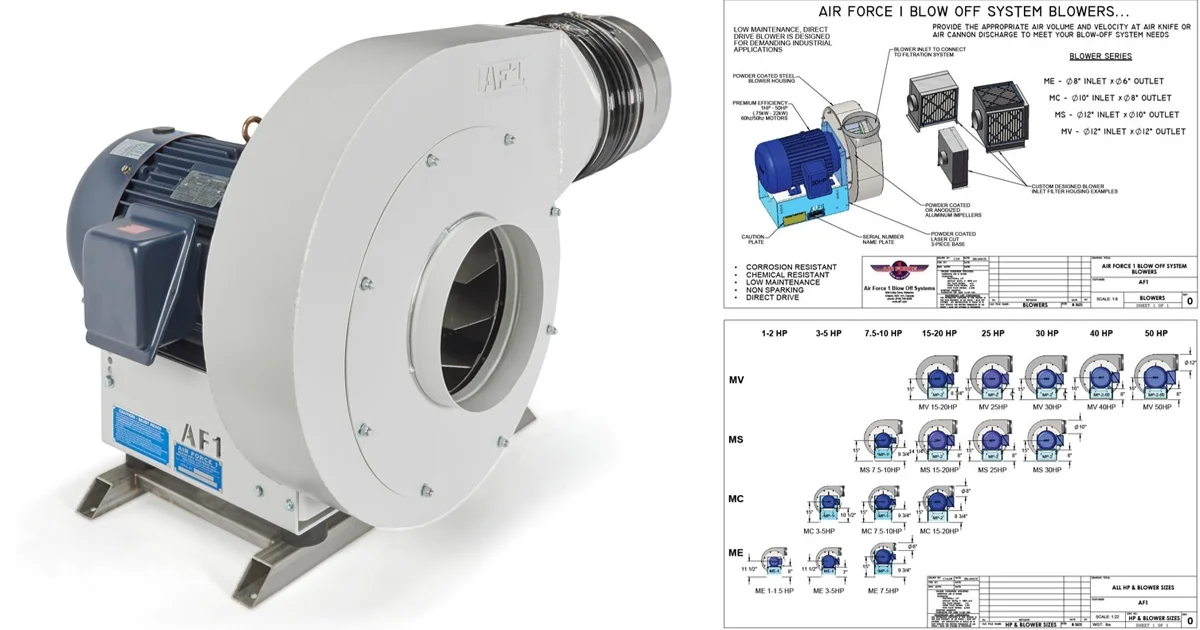
Every minute your blower runs affects your operating costs and system reliability. Choosing between a direct drive and belt drive blower isn’t just about selecting equipment – it’s about deciding on a maintenance strategy and efficiency level that fits your facility’s needs.
Each system has clear trade-offs. A direct drive blower connects the motor directly to the fan, eliminating extra components. Fewer moving parts mean less wear, fewer repairs, and steady, reliable airflow, which is ideal for continuous operation. Belt drive blowers, on the other hand, offer adjustable speeds and a lower upfront cost, but require regular maintenance and part replacements to keep running efficiently.
For plant managers, the right choice depends on what matters most to your facility. If you need steady performance with minimal upkeep, direct drive is often the best option. If variable speeds and a lower initial cost are a priority, belt drive may be the right fit – as long as routine maintenance is factored in. This guide breaks down the key differences to help you make the best decision for your operation.
What Is a Direct Drive Blower?
A direct drive blower connects the motor directly to the fan, eliminating belts and pulleys that require adjustments and replacements. With fewer moving parts, these systems reduce the risk of breakdowns and lower maintenance demands, making them ideal for facilities that require continuous, reliable airflow with minimal downtime.

Key Advantages
Direct drive blowers offer several important benefits:
Energy Efficiency - Power moves directly to the fan, reducing energy loss from friction
Lower Maintenance - Fewer moving parts mean less frequent servicing and fewer repairs
Space Savings - The compact design fits in tighter spaces
Quieter Operation - Less vibration and noise without belt systems
Steady Performance - Reliable airflow without ups and downs
Where They Work Best
These systems excel in places that need consistent airflow and minimal upkeep:
Building Climate Control - Keeps commercial and residential spaces comfortable
Medical Facilities - Maintains clean air where contamination risks matter
Manufacturing Plants - Provides steady ventilation for production areas
Data Centers - Delivers reliable cooling for sensitive computer equipment
The combination of efficiency, reliability, and low maintenance makes direct drive blowers ideal for facilities that need dependable airflow without constant attention.
What Is a Belt Drive Blower?
A belt drive blower uses a system of belts and pulleys to transfer power from the motor to the fan. This design allows adjustable speeds, making it useful for facilities that require variable airflow rates. However, the added components require regular inspections, tension adjustments, and part replacements to maintain efficiency.
What Sets Them Apart
The belt system brings important advantages but requires some trade-offs:
Speed Control - Adjust airflow to match varying facility requirements
Strong Air Pressure - Handles long duct systems and filtration setups effectively
Regular Maintenance - Belts need inspection and periodic replacement
More Space Needed - Belt and pulley system requires additional room
Adaptable Performance - Ideal for operations with changing air demands
Where They Work Best
Belt drive blowers excel in environments requiring variable air speeds:
Manufacturing Plants - Different processes need different airflow rates
Large Buildings - Ventilation demands change throughout the day
Big HVAC Systems - Serves hospitals, malls, and office complexes
Dust Collection - Removes debris in workshops and industrial settings
These systems need more maintenance and use slightly more energy than direct drive blowers. However, many facilities find this acceptable when they need precise control over their airflow. The ability to adjust speeds makes belt drive blowers particularly valuable in operations where ventilation needs fluctuate regularly.
Choosing Between Direct Drive and Belt Drive: What Really Matters
Picking the right blower system affects your energy bills, maintenance time, and how well your facility runs. Let's compare direct drive and belt drive systems across key areas that matter to your business.
Energy Use and Efficiency
Direct drive systems waste less energy because the motor connects straight to the fan. No power gets lost along the way, which means lower energy bills. Belt drive systems lose some energy through their belts and pulleys. While newer belt systems work better than older ones, they still use more power than direct drive to move the same amount of air.
Maintenance Time and Costs
Direct drive systems need less attention because they have fewer parts that can wear out. With no belts to check or replace, you spend less time on maintenance. Belt drive systems need regular care – you'll have to check the belts, adjust their tension, and replace them periodically. When belts aren't lined up right, they wear unevenly and can cause problems.
Upfront vs. Long-term Costs
You'll pay more at first for a direct drive system, but it usually saves money over time through lower energy and maintenance costs. Belt drive systems cost less to buy initially but expect to spend more on upkeep and energy as time goes on.
Controlling Airflow
Belt drive systems shine when you need to change airflow often. You can adjust the fan speed by modifying the belt and pulley setup. This makes them perfect for buildings with changing air needs. Direct drive systems run at set speeds – reliable and efficient, but less flexible.
Space and Durability
Direct drive systems take up less space and typically last longer because they're simpler. Belt drive systems need extra room for their belts and pulleys, and their additional parts mean more things can wear out over time.
Making Your Choice
If low maintenance, energy efficiency, and long-term reliability are your top priorities, direct drive is typically the most practical choice. However, if adjustable airflow and a lower upfront cost are more important for your facility, a belt drive system may be a suitable alternative – as long as the additional maintenance is factored into your long-term planning. Your choice should match what matters most for your facility - whether that's flexibility, efficiency, or maintenance needs.
Benefits of Direct Drive Blowers
Energy Savings
Direct drive blowers save power because the motor connects right to the fan. No energy gets wasted through belt friction or slippage, which means lower electricity bills. This design helps businesses meet modern energy standards and cut operating costs. Many facilities choose direct drive systems specifically to reduce their energy use and support their sustainability goals.
Less Maintenance, More Uptime
Without belts and pulleys to maintain, direct drive systems need far less attention. This matters most in places like data centers, clean rooms, and hospitals, where stopping the airflow causes serious problems. Fewer moving parts means less wear and tear, so you'll spend less time and money on maintenance. Your system stays running when you need it, with fewer surprise breakdowns.
Space-Saving Design
Direct drive blowers take up less room than belt drive systems. This makes them perfect for tight spaces in commercial buildings, labs, and industrial settings. Since they don't need space for belts and pulleys, you have more options for where to install them.
Perfect For These Industries
Direct drive works best where steady, reliable airflow matters most:
Building heating and cooling systems
Medical facilities and clean rooms that need pure air
Data centers that must stay cool
Food processing areas that require clean conditions
Choose direct drive when you want to save energy, minimize maintenance, and keep your system running reliably.
Benefits of Belt Drive Blowers
Adjustable Speed Control
Belt drive blowers let you change fan speeds to match your needs. Unlike direct drive systems that run at one speed, belt drives can be adjusted throughout the day. By changing the pulley settings, you can fine-tune your airflow and match it exactly to what your facility needs.
Handles Tough Jobs
These systems work well in buildings with long air ducts or complex filtration systems. Belt drives can push air through extended ductwork and multiple filters, making them ideal for industrial settings and large commercial buildings.
Cost Considerations
Belt drive systems cost less to buy initially, which helps if you're working with a tight budget. While they need regular maintenance and belt replacements, their ability to adjust speeds can help save energy in certain situations, which may offset some maintenance costs over time.
Works Best in These Settings
Belt drive systems shine in places that need flexible airflow:
Manufacturing plants where air needs change often
Large warehouses needing consistent ventilation
Big building HVAC systems
Dust collection systems in factories and workshops
Pick belt drive when you need to adjust airflow often and can handle regular maintenance.
Choosing the Right Blower for Your Application
When selecting a blower system, consider your facility's specific needs. The choice between direct drive and belt drive significantly impacts your operations, maintenance requirements, and long-term costs.
When to Choose Direct Drive
Direct drive systems excel in environments requiring consistent, reliable airflow. These systems work best when energy efficiency and minimal maintenance are priorities. With fewer moving parts, they offer dependable performance and lower operating costs over time. Consider direct drive for critical operations like data centers, healthcare facilities, and clean rooms where steady airflow is essential.
When to Choose Belt Drive
Belt drive systems shine in applications needing variable airflow control. Their adjustable speed capabilities make them ideal for facilities with changing ventilation requirements. While they need more maintenance, their flexibility suits manufacturing plants, warehouses, and industrial settings where air demands fluctuate throughout operations.
Balancing Cost vs. Long-Term Performance
Initial cost shouldn't be your only consideration. Direct drive systems cost more upfront but deliver savings through energy efficiency and reduced maintenance. Belt drive systems offer lower initial costs but require regular maintenance and belt replacements. Consider your total cost of ownership when making your decision.
Making Your Choice
Your ideal blower system depends on your specific operational needs. Choose direct drive when you need:
Consistent, reliable airflow
Maximum energy efficiency
Minimal maintenance
Long-term cost savings
Select belt drive when you require:
Adjustable air speeds
Flexible operation
Lower upfront costs
Variable airflow control
Selecting the right blower system is a key decision that impacts your facility’s performance and costs. Understanding your airflow requirements, maintenance capacity, and energy usage will help determine the best option. If you need expert insights, our team is available to discuss your specific needs.

